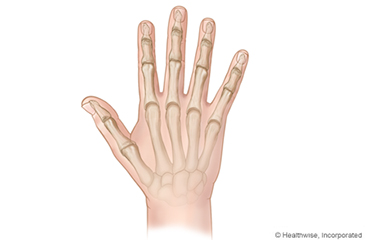
Overview
Breaks in the bones of the finger usually heal well in about 3 to 4 weeks. The pain and swelling from a broken finger can last for weeks. But it should steadily improve, starting a few days after your child breaks it.
It is very important that your child wear and take care of the cast or splint exactly as the doctor says, so that the finger heals properly and does not end up crooked. Wearing a splint may interfere with your child's normal activities. Your child may need help with daily tasks.
Healthy habits can help your child heal. Give your child a variety of healthy foods. And don't smoke around your child.
Follow-up care is a key part of your child's treatment and safety. Be sure to make and go to all appointments, and call your doctor if your child is having problems. It's also a good idea to know your child's test results and keep a list of the medicines your child takes.
How can you care for your child at home?
- If the doctor put a splint on the finger, make sure your child wears the splint exactly as directed. Do not remove it until the doctor says that you can.
- Keep your child's hand raised above the level of the heart as much as you can. This will help reduce swelling.
- Put ice or a cold pack on the finger for 10 to 20 minutes at a time. Try to do this every 1 to 2 hours for the next 3 days (when your child is awake) or until the swelling goes down. Put a thin cloth between the ice and your child's skin. Keep the splint dry.
- Be safe with medicines. Give pain medicines exactly as directed.
- If the doctor gave your child a prescription medicine for pain, give it as prescribed.
- If your child is not taking a prescription pain medicine, ask the doctor if your child can take an over-the-counter medicine.
When should you call for help?
Call 911 anytime you think your child may need emergency care. For example, call if:
- Your child's finger is cool or pale or changes color.
Call your doctor now or seek immediate medical care if:
- Your child's pain gets much worse.
- Your child has tingling, weakness, or numbness in the finger.
- Your child has signs of infection, such as:
- Increased pain, swelling, warmth, or redness.
- Red streaks leading from the area.
- Pus draining from the area.
- A fever.
Watch closely for changes in your child's health, and be sure to contact your doctor if:
- Your child's finger is not steadily improving.
Where can you learn more?
Go to http://www.healthwise.net/patientEd
Enter R286 in the search box to learn more about "Finger Fracture in Children: Care Instructions".
Current as of: July 31, 2024
Author: Ignite Healthwise, LLC Staff
Clinical Review Board
All Ignite Healthwise, LLC education is reviewed by a team that includes physicians, nurses, advanced practitioners, registered dieticians, and other healthcare professionals.

